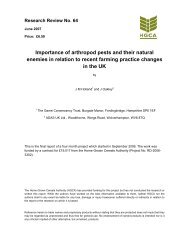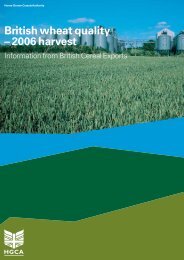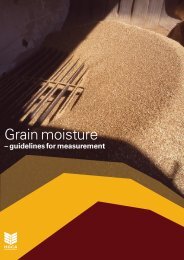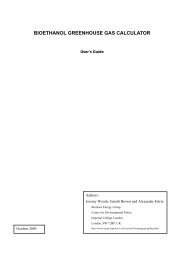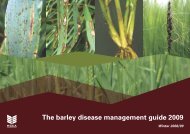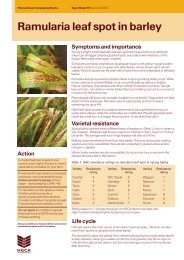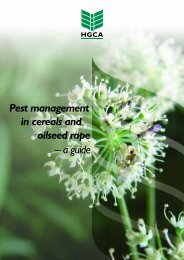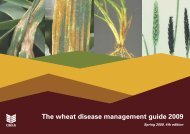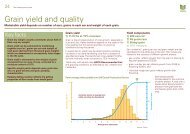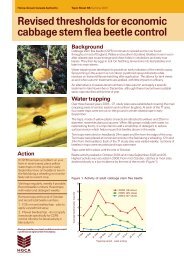Integrated control of wheat blossom midge - HGCA
Integrated control of wheat blossom midge - HGCA
Integrated control of wheat blossom midge - HGCA
Create successful ePaper yourself
Turn your PDF publications into a flip-book with our unique Google optimized e-Paper software.
and 14 days after Soissons for the other varieties on the current Recommended List tested. In 2002, wbmactivity was biased towards later emerging varieties at all sites. In 2004, the main bias was towards earlyemerging varieties and sites. The 2003 year differed in this respect with some having an early bias and somea late bias. Over the three years <strong>of</strong> experiments the bias evened out allowing an assessment <strong>of</strong> anyunderlying differences in vulnerability; however, the results highlight the danger <strong>of</strong> drawing conclusionsabout this trait from the results from single sites or years. An examination <strong>of</strong> the results for those varietiesgrown over all three cropping years showed that there were significant differences between varieties in terms<strong>of</strong> vulnerability (Table 1), with the most vulnerable variety twice as vulnerable as the least.Table 1. Mean numbers <strong>of</strong> larvae found compared to mean <strong>of</strong> <strong>control</strong>s.Variety Larval score Significance*ECO 22 139.3 dOption (C) 121.9 cdXi 19 108.3 bcTanker (C) 105.3 bcSolstice 99.6 bcMalacca (C) 94.7 abcConsort (C) 89.7 abClaire (C) 88.5 abEinstein 73.3 aPennant 73.0 aNb. Values followed by the same letter do differ at the 5% significance level.ToleranceThe intention to measure tolerance by introducing plots treated with chlorpyrifos was confounded by veryvariable <strong>control</strong> on different varieties and by the incidental <strong>control</strong> <strong>of</strong> aphid infestations which decreasedyields on untreated plots at some sites. The discovery <strong>of</strong> resistant varieties with their yields unaffected bythe degree <strong>of</strong> <strong>midge</strong> infestation at each site allowed an alternative method <strong>of</strong> assessing yield loss againstnumbers <strong>of</strong> larvae found. The results were still subject to a large variation between sites, which may havemasked any differences between varieties due to tolerance <strong>of</strong> damage.The relative ranking <strong>of</strong> the different causes in variation between sites was: coincidence > vulnerability >tolerance.3



